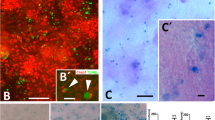Abstract
The protooncogene protein, Bcl-2, protects cells from apoptosis and ensures their survival in vitro by inhibiting the action of the apoptosis-inducer, Bax. Its expression in proliferative and long-lived cells in vivo also indicates that it protects against cell death. The chondrocytes of the epiphyseal plate cartilage undergo a series of maturation steps and deposit mineral in the cartilage matrix before dying. The possibility that Bcl-2 helps protect chondrocytes until mineral deposition is completed was investigated by determining the distribution of Bcl-2 immunoreactivity in the epiphyseal plate cartilage of growing rats and its subcellular localization, using a specific antibody. The involvement of Bax in the triggering of chondrocyte death was checked by immunocytochemistry. Bcl-2 expression in the osteoblasts and the final result of their evolution, the osteocytes, was also examined in trabecular bone. Bcl-2 immunoreactivity was non-uniformly distributed throughout the epiphyseal cartilage. It was maximal in proliferative chondrocytes, decreased in mature chondrocytes, and low in hypertrophic chondrocytes, whereas there was Bax immunoreactivity in all chondrocytes examined. Immunolabeling was intense in osteoblasts but considerably lower in fully differentiated osteocytes. Bcl-2 immunoreactivity was mainly in the cytoplasm of chondrocytes, osteoblasts, and early osteocytes; the nuclei appeared clear. The subcellular distribution of Bcl-2 immunolabeling in chondrocytes, revealed by gold particles in the electron microscope, showed that gold particles were frequently concentrated in the mitochondria in all the cartilage zones and lay mainly within the organelles, not at their periphery. The endoplasmic reticulum contained moderate immunoreactivity and there were few gold particles in the cytoplasm and nuclei. The number of gold particles decreased in all the subcellular compartments from proliferative to hypertrophic chondrocytes. In contrast, Bax immunoreactivity changed little during chondrocyte terminal evolution, and its subcellular distribution mirrored that of Bcl-2. These immunocytochemical data indicate that Bcl-2 helps maintain chondrocytes and osteoblasts until their terminal maturation.
Similar content being viewed by others
Author information
Authors and Affiliations
Additional information
Accepted: 19 February 1997
Rights and permissions
About this article
Cite this article
Wang, Y., Toury, R., Hauchecorne, M. et al. Expression of Bcl-2 protein in the epiphyseal plate cartilage and trabecular bone of growing rats. Histochemistry 108, 45–55 (1997). https://doi.org/10.1007/s004180050145
Issue Date:
DOI: https://doi.org/10.1007/s004180050145




